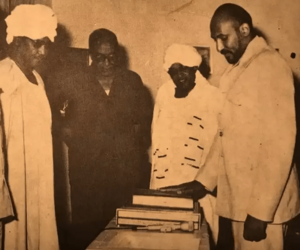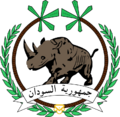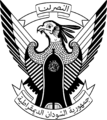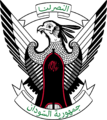Democratic Republic of Sudan facts for kids
Quick facts for kids
Democratic Republic of the Sudan
|
|||||||||
|---|---|---|---|---|---|---|---|---|---|
| 1969–1985 | |||||||||
|
Flag
(1970–1985) |
|||||||||
|
Motto: النصر لنا
"Victory is ours" |
|||||||||
|
Anthem: نحن جند الله، جند الوطن (Arabic)
Naḥnu Jund Allah, Jund Al-waṭan (English: "We are the Soldiers of God, the Soldiers of the Nation") |
|||||||||
 |
|||||||||
| Capital | Khartoum | ||||||||
| Common languages | Arabic English Other languages of Sudan |
||||||||
| Religion | Islam Animism Christianity |
||||||||
| Government | Unitary one-party socialist republic under a military dictatorship | ||||||||
| President | |||||||||
|
• 1969–1985
|
Gaafar Nimeiry | ||||||||
| Vice President | |||||||||
|
• 1969–1971
|
Babiker Awadalla | ||||||||
|
• 1971–1972
|
Abel Alier | ||||||||
|
• 1972–1976
|
Mohamed Al-Baghir Ahmed | ||||||||
|
• 1976–1979
|
Abuelgasim Mohamed Hashim | ||||||||
|
• 1979–1982
|
Abdul Majid Hamid Khalil | ||||||||
| Prime minister | |||||||||
|
• 1969
|
Babiker Awadalla | ||||||||
|
• 1969–1976
|
Gaafar Nimeiry | ||||||||
|
• 1976–1977
|
Rashid Bakr | ||||||||
|
• 1977–1985
|
Gaafar Nimeiry | ||||||||
| Historical era | Cold War | ||||||||
|
• Coup d'état
|
25 May 1969 | ||||||||
|
• Disestablished
|
6 April 1985 | ||||||||
| Area | |||||||||
|
• Total
|
2,530,397 km2 (976,992 sq mi) (9th) | ||||||||
| Currency | Sudanese pound | ||||||||
| ISO 3166 code | SD | ||||||||
|
|||||||||
| Today part of | Sudan South Sudan |
||||||||
The Democratic Republic of the Sudan was the name of Sudan between 1969 and 1985. It began on May 25, 1969, when a group of young army officers took control of the country. This event was a coup d'état, which means they took power suddenly and often by force.
The officers called themselves the Free Officers Movement. Their leader was Colonel Gaafar Nimeiry. He became the new head of the country. This period is often called the Nimeiry era or the May Regime. Nimeiry said he took over because the old government was not making decisions. He also felt they were not solving the country's money problems or issues between different regions.
Contents
History of the May Regime
How the Government Changed
After the coup, the leaders formed a group called the Revolutionary Command Council (RCC). This council had ten members, with Nimeiry as its chairman. They announced that Sudan would be a "democratic republic" with "Sudanese socialism." This meant they wanted a government that cared about its people and shared wealth more evenly.
The RCC quickly made big changes. They stopped the old constitution and banned all political parties. They also took control of many businesses, banks, and factories, making them state-owned. Nimeiry also arrested many former politicians and retired senior army officers.
Babiker Awadallah, a former chief justice, became the prime minister. He led a cabinet of twenty-one members, including Nimeiry. Some people in the cabinet had socialist ideas. The RCC worked with these groups to help shape the new government's plans.
In November 1969, Nimeiry took over as prime minister himself. Awadallah remained an important figure in the government.
Dealing with Opposition
One of the biggest challenges for the new government came from a religious group called the Ansar. Their leader, Imam al-Hadi al-Mahdi, wanted the old democratic government back. He also wanted to remove people with socialist ideas from power.
In March 1970, fighting broke out between government forces and about 30,000 Ansar followers on Aba Island. The government used army units and air support to attack the island. Around 3,000 people died in the battle. The Imam tried to escape but was killed near the border. His nephew, Sadiq al-Mahdi, who was a former prime minister, was sent away to Egypt.
After dealing with this group, Nimeiry focused on controlling other political groups. He wanted to reduce the influence of the Sudanese Communist Party (SCP). He ordered their leader, Abdel Khaliq Mahjub, to leave the country. When Mahjub returned secretly, Nimeiry put him under house arrest.
In 1971, Nimeiry announced plans for a new national political movement called the Sudan Socialist Union (SSU). This new group would be the only allowed political party. After this, many SCP leaders were arrested.
However, the SCP still had secret members. On July 19, 1971, some SCP members tried to overthrow Nimeiry in a coup. They took control of the presidential palace. But three days later, loyal army units rescued Nimeiry. The coup leaders were arrested, and some were executed.
After surviving this coup, Nimeiry continued to build his socialist state. A new constitution was created in August 1971. It said Sudan was a "socialist democracy" and set up a presidential system. The next month, Nimeiry was elected president for a six-year term.
The Southern Conflict
A civil war had been going on in the southern part of Sudan since the 1950s. This conflict was between the northern government and southern rebels. By the late 1960s, about 500,000 people had died. Many southerners had to hide in forests or flee to other countries.
The southern rebels, called the Anyanya, got weapons and supplies from other countries. They controlled much of the countryside, while government forces held the main towns.
After the 1969 coup, the government tried to negotiate with the rebels. When talks failed, the government sent more troops to the south. They also received military equipment from the Soviet Union.
In 1971, Joseph Lagu became the leader of the southern forces. He created the Southern Sudan Liberation Movement (SSLM). Most southern leaders supported him.
Nimeiry was determined to end the war in the south. He believed he could bring peace by giving the southern region some self-government and helping it develop. In October 1971, the government started talking with the SSLM.
A peace conference was held in Addis Ababa, Ethiopia, in February 1972. With help from Ethiopia's Emperor Haile Selassie, both sides reached an agreement.
The Addis Ababa accords gave the southern region self-rule. This region included three provinces: Equatoria, Bahr al Ghazal, and Upper Nile. The agreement said the south would have its own regional assembly and a local government. However, the national government would still control defense, foreign affairs, and money.
The agreement also allowed southern soldiers, including former Anyanya fighters, to join the Sudanese army. Arabic was recognized as Sudan's official language, and English became the main language in the south for government and schools.
Even though some southern leaders disagreed, Joseph Lagu approved the terms. Both sides agreed to stop fighting. The government made the agreement official and offered forgiveness to returning refugees. The Addis Ababa Agreement was signed on March 27, 1972. This day was later celebrated as National Unity Day.
Political Changes After Peace
After the peace in the south, Nimeiry tried to improve relations with Muslim religious groups in the north. The government made changes to give more power to rural areas. They also said that Islam was important in the country and that Sharia (Islamic law) would be the basis for laws.
In 1973, a new constitution was created. It kept the presidential government and said the SSU was the only political organization. It also supported self-rule for the south. The constitution stated that Islam was Sudan's official religion but recognized Christianity for many citizens.
However, many people were unhappy with Nimeiry's policies. There were food shortages, and some conservatives felt the peace deal with the south was a mistake. There were attempts to overthrow Nimeiry in 1973 and 1974. Students and others also went on strike. Nimeiry responded by declaring a state of emergency and arresting many people who disagreed with him.
A group called the National Front formed in 1974. It included different opposition groups. In July 1976, there was another attempt to overthrow Nimeiry, inspired by the Ansar group. Government soldiers quickly stopped it. Despite this unrest, Nimeiry was reelected president in 1977 with almost all the votes.
National Reconciliation

After the 1976 coup attempt, Nimeiry and his opponents decided to try to make peace. In 1977, Nimeiry met with Sadiq al Mahdi, a leader of the opposition, in Port Sudan. They signed an agreement called the "national reconciliation."
This agreement allowed opposition groups to rejoin national life. It also brought back civil liberties, freed political prisoners, and promised to reform local government. About 1,000 prisoners were released, and Sadiq al Mahdi was allowed to return. The SSU also allowed former opposition supporters to join. Sadiq encouraged his followers to work within the single-party system.
In 1978, elections for the People's Assembly were held. Nimeiry allowed former opposition members to run as independent candidates. They won many seats, which seemed like a step towards more democracy. However, this also weakened the SSU party.
During this time, Nimeiry became closer to Islamist ideas. Hassan al-Turabi, an Islamist leader who had been imprisoned, was invited back and became Justice Minister in 1979.
Nimeiry's government faced more problems, including corruption. To stay in power, Nimeiry became more strict. He ordered the arrest of thousands of opponents without trial. He also removed ministers and military officers who seemed to be gaining too much power. This made him lose touch with the public's feelings.
In 1983, Nimeiry decided to divide the Southern Region back into three smaller provinces. He had already suspended the Southern Regional Assembly. This decision was opposed by a new southern group called the Sudanese People's Liberation Movement (SPLM) and its army, the Sudanese People's Liberation Army (SPLA). They wanted a united Sudan.
A few months later, in September 1983, Nimeiry announced that Sharia (Islamic law) would be the basis of Sudan's legal system. These new laws, known as the September Laws, were not popular with many people, especially non-Muslim southerners. The SPLM strongly criticized the Sharia laws. By the end of 1983, the security situation in the south had worsened, leading to the start of another civil war.
The End of Nimeiry's Rule
In early 1985, people in Khartoum started protesting against the government. They were upset about rising prices for food, gas, and transportation. A general strike paralyzed the country. Nimeiry was visiting the United States at the time and could not stop the protests.
On April 6, 1985, a bloodless military coup took place. Nimeiry's defense minister, Gen. Abdel Rahman Swar al-Dahab, led the coup and removed Nimeiry from power. Later, Sadiq al-Mahdi, who had tried to overthrow Nimeiry before, became Prime Minister.
Gallery
See also
- History of Sudan
- First Sudanese Civil War








